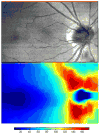Spectral domain optical coherence tomography and glaucoma
- PMID: 18936635
- PMCID: PMC2679587
- DOI: 10.1097/IIO.0b013e318187e801
Spectral domain optical coherence tomography and glaucoma
Figures












Similar articles
-
Detection of macular ganglion cell loss in preperimetric glaucoma patients with localized retinal nerve fibre defects by spectral-domain optical coherence tomography.Clin Exp Ophthalmol. 2013 Dec;41(9):870-80. doi: 10.1111/ceo.12142. Epub 2013 Jul 5. Clin Exp Ophthalmol. 2013. PMID: 23777476
-
Evaluation of retinal nerve fiber layer progression in glaucoma: a comparison between spectral-domain and time-domain optical coherence tomography.Ophthalmology. 2011 Aug;118(8):1558-62. doi: 10.1016/j.ophtha.2011.01.026. Epub 2011 Apr 29. Ophthalmology. 2011. PMID: 21529954
-
Neuro-ophthalmic disease and optical coherence tomography: glaucoma look-alikes.Curr Opin Ophthalmol. 2011 Mar;22(2):124-32. doi: 10.1097/ICU.0b013e328343c1a3. Curr Opin Ophthalmol. 2011. PMID: 21307679 Review.
-
Retinal nerve fiber layer imaging with spectral-domain optical coherence tomography: pattern of RNFL defects in glaucoma.Ophthalmology. 2010 Dec;117(12):2337-44. doi: 10.1016/j.ophtha.2010.04.002. Epub 2010 Aug 3. Ophthalmology. 2010. PMID: 20678802
-
OCT for glaucoma diagnosis, screening and detection of glaucoma progression.Br J Ophthalmol. 2014 Jul;98 Suppl 2(Suppl 2):ii15-9. doi: 10.1136/bjophthalmol-2013-304326. Epub 2013 Dec 19. Br J Ophthalmol. 2014. PMID: 24357497 Free PMC article. Review.
Cited by
-
Comparative analysis of mean retinal thickness measured using SD-OCT in normal young or old age and glaucomatous eyes.Int Ophthalmol. 2018 Dec;38(6):2417-2426. doi: 10.1007/s10792-017-0744-7. Epub 2017 Oct 12. Int Ophthalmol. 2018. PMID: 29027057
-
The effect of software upgrade on optical coherence tomography measurement of the retinal nerve fiber layer thickness.Middle East Afr J Ophthalmol. 2012 Oct;19(4):392-6. doi: 10.4103/0974-9233.102745. Middle East Afr J Ophthalmol. 2012. PMID: 23248541 Free PMC article.
-
Intraluminal Deposits Found in Glaucoma Tube Shunts Via Anterior Segment Ocular Coherence Tomography.J Glaucoma. 2018 Mar;27(3):e68-e71. doi: 10.1097/IJG.0000000000000840. J Glaucoma. 2018. PMID: 29240598 Free PMC article.
-
Facilitating glaucoma diagnosis with intereye neuroretinal rim asymmetry analysis using spectral-domain optical coherence tomography.Digit J Ophthalmol. 2022 Dec 26;28(4):100-109. doi: 10.5693/djo.01.2022.10.001. eCollection 2022. Digit J Ophthalmol. 2022. PMID: 36660188 Free PMC article.
-
Reproducibility of retinal nerve fiber layer thickness measurements using spectral domain optical coherence tomography.J Glaucoma. 2011 Oct;20(8):470-6. doi: 10.1097/IJG.0b013e3181f3eb64. J Glaucoma. 2011. PMID: 20852437 Free PMC article.
References
-
- The International Bank for Reconstruction and Development—The World Bank. WorldAQ3 Development Report. Oxford: Oxford University Press; 1993.
-
- Dielemans I, Vingerling JR, Wolfs RC, et al. The prevalence of primary open-angle glaucoma in a population-based study in the Netherlands. The Rotterdam Study. Ophthalmology. 1994;101:1851–1855. - PubMed
-
- Leske MC, Connell AM, Schachat AP, et al. The Barbados Eye Study. Prevelance of open angle glaucoma. Arch Ophthalmol. 1994;112:821–829. - PubMed
-
- Mitchell P, Smith W, Attebo K, et al. Prevalence of open-angle glaucoma in Australia. The Blue Mountains Eye Study. Ophthalmology. 1996;103:1661–1669. - PubMed
Publication types
MeSH terms
Grants and funding
LinkOut - more resources
Full Text Sources
Other Literature Sources
Medical

